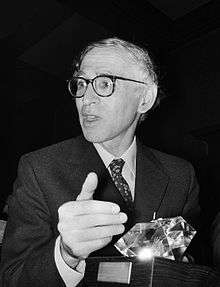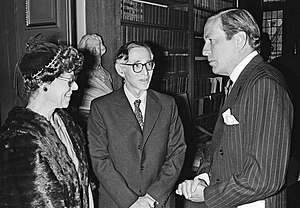Aaron Klug
Sir Aaron Klug OM FRS FMedSci HonFRMS[3] (11 August 1926 – 20 November 2018)[7][8] was a Lithuanian-born, South African-educated, British biophysicist, and winner of the 1982 Nobel Prize in Chemistry for his development of crystallographic electron microscopy and his structural elucidation of biologically important nucleic acid-protein complexes.[9][10][11][12][13][1][14]
Sir Aaron Klug | |
|---|---|
 Aaron Klug in 1979 | |
| Born | 11 August 1926[1] Želva, Lithuania |
| Died | 20 November 2018 (aged 92) Cambridge, UK |
| Nationality | British |
| Education | Durban High School |
| Alma mater |
|
| Known for | Crystallographic electron microscopy[2] |
| Spouse(s) | Liebe Bobrow ( m. 1948) |
| Children | Two[1] |
| Awards |
|
| Scientific career | |
| Fields | |
| Institutions |
|
| Thesis | The kinetics of phase changes in solids (1953) |
| Doctoral advisor | Douglas Hartree[6] |
| Website | www2 |
Early life and education

Klug was born in Želva, Lithuania to Jewish parents Lazar, a cattleman, and Bella (née Silin) Klug, with whom he moved to South Africa at the age of two.[15][16] He was educated at Durban High School.[1] Paul de Kruif's book Microbe Hunters aroused his interest in microbiology.[17]
He started to study microbiology, but then moved into physics and maths, graduating with a Bachelor of Science degree at the University of the Witwatersrand Johannesburg. He studied physics and obtained his Master of Science degree at the University of Cape Town.[1] He was awarded an 1851 Research Fellowship from the Royal Commission for the Exhibition of 1851,[18] which enabled him to move to England, completing his PhD in research physics at Trinity College, Cambridge in 1953.[19]
Career and research
Following his PhD, Klug moved to Birkbeck College in the University of London in late 1953, and started working with virologist Rosalind Franklin in the lab of crystallographer John Bernal. This experience aroused a lifelong interest in the study of viruses, and during his time there he made discoveries in the structure[20] of the tobacco mosaic virus. In 1962 he moved to the newly built Medical Research Council (MRC) Laboratory of Molecular Biology (LMB) in Cambridge. Over the following decade Klug used methods from X-ray diffraction, microscopy and structural modelling to develop crystallographic electron microscopy in which a sequence of two-dimensional images of crystals taken from different angles are combined to produce three-dimensional images of the target. He studied the structure of transfer RNA, and found what is known as zinc fingers as well as the neurofibrils in Alzheimer's disease.[17]
Also in 1962 Klug had been offered a teaching Fellowship at Peterhouse, Cambridge. After receiving the Nobel Prize in Chemistry in 1982, he went on teaching because he found the courses interesting and was later made an Honorary Fellow at the College.[1][21]
Between 1986 and 1996 he was director of the Laboratory of Molecular Biology in Cambridge. Klug served on the Advisory Council for the Campaign for Science and Engineering.[22] He also served on the Board of Scientific Governors at The Scripps Research Institute.[23] He and Dai Rees approached the Wellcome Trust to found the Wellcome Sanger Institute, which was a key player in the Human Genome Project.[17]
Awards and honours
Klug was awarded the Louisa Gross Horwitz Prize from Columbia University in 1981. He was knighted by Elizabeth II in 1988.[24] In 1969 he was elected a Fellow of the Royal Society (FRS),[3][25] the oldest national scientific institution in the world. He was elected its President (PRS) from 1995–2000. He was appointed to the Order of Merit in 1995 – as is customary for Presidents of the Royal Society. His certificate of election to the Royal Society reads:
Mathematical physicist and crystallographer distinguished for his contributions to molecular biology, especially the structure of viruses. Development of a theory of simultaneous temperature and phase changes in steels led him to apply related mathematical methods to the problem of diffusion and chemical reactions of gases in thin layers of haemoglobin solutions and in red blood cells. Then the late Rosalind Franklin introduced him to the x-ray study of tobacco mosaic virus to which he contributed by his application and further development of Cochran and Crick's theory of diffraction from helical chain molecules. Klug's most important work is concerned with the structure of spherical viruses. Together with D. Caspar he developed a general theory of spherical shells built up of a regular array of asymmetric particles. Klug and his collaborators verified the theory by x-ray and electron microscope studies, thereby revealing new and hitherto unsuspected features of virus structure.[26]
In 2000, Klug received the Golden Plate Award of the American Academy of Achievement.[27] In 2005, he was awarded South Africa's Order of Mapungubwe (gold) for exceptional achievements in medical science.[28] He was elected a Fellow of the Academy of Medical Sciences (FMedSci).[29]
In 2013, Israel's Ben-Gurion University of the Negev dedicated their centre for structural biology in Klug's name, Aaron Klug Integrated Centre for Biomolecular Structure. He, his family and the then-British Ambassador to Israel Matthew Gould, were in attendance. Klug was well associated with the university and the town of Be'er Sheva, having visited them numerous times.[30][31][32]
Personal life
Klug married Liebe Bobrow in 1948.[1] Though Klug had faced discrimination in South Africa, he remained religious and according to Sydney Brenner, he became more religious in his older age.[33]
References
- Anon (2015). "Klug, Sir Aaron". Who's Who. ukwhoswho.com (online Oxford University Press ed.). A & C Black, an imprint of Bloomsbury Publishing plc. doi:10.1093/ww/9780199540884.013.U23297. (subscription or UK public library membership required) (subscription required)
- Shafrir, E. (1994). "Aaron Klug--a pioneer of crystallographic electron microscopy". Israel Journal of Medical Sciences. 30 (9): 734. PMID 8088991.
- "Sir Aaron Klug OM FRS". London: Royal Society. Archived from the original on 7 November 2015.
- "Honourary Fellows". Royal Microscopical Society. Retrieved 20 February 2017.
- "Honorary Fellows Past and Present". Royal Microscopical Society. Retrieved 20 February 2017.
- Aaron Klug at the Mathematics Genealogy Project
- Obituaries, The Telegraph (22 November 2018). "Sir Aaron Klug, OM, scientist who won a Nobel Prize for his work on electron microscopy and chromosomes – obituary". The Telegraph – via www.telegraph.co.uk.
- "Aaron Klug (1926 - 2018) - MRC Laboratory of Molecular Biology". 21 November 2018.
- Nobel Foundation (18 October 1982). "The Nobel Prize in Chemistry 1982" (Press release). The Royal Swedish Academy of Sciences. Retrieved 13 September 2007.
- Wakabayashi, K. (1983). "Accomplishment of Dr. Aaron Klug, winner of Nobel prize in chemistry, 1982". Tanpakushitsu Kakusan Koso. Protein, Nucleic Acid, Enzyme. 28 (2): 156–157. PMID 6342048.
- Shampo, M. A.; Kyle, R. A. (1994). "Sir Aaron Klug--Nobel Prize winner for chemistry". Mayo Clinic Proceedings. 69 (6): 556. doi:10.1016/S0025-6196(12)62247-2. PMID 8189761.
- "Aaron Klug biography". nobelprize.org.
- Finch, John (2008). A Nobel Fellow on Every Floor. Medical Research Council. ISBN 978-1-84046-940-0. this book is all about the MRC Laboratory of Molecular Biology, Cambridge.
- Aaron Klug archive collection - Churchill Archives Centre finding aid.
- "The Papers of Sir Aaron Klug". Churchill Archives Centre. Retrieved 3 March 2016.
- "Desert Island Discs – Castaway : Sir Aaron Klug first broadcast 2002-05-12". BBC.
- Watts, Geoff (2018). "Aaron Klug". The Lancet. 392 (10164): 2546. doi:10.1016/S0140-6736(18)33109-X.
- 1851 Royal Commission Archives
- Klug, Aaron (1953). The kinetics of phase changes in solids (PhD thesis). University of Cambridge. ProQuest 301283484.
- Amos, L.; Finch, J. T. (2004). "Aaron Klug and the revolution in biomolecular structure determination". Trends in Cell Biology. 14 (3): 148–152. doi:10.1016/j.tcb.2004.01.002. PMID 15003624.
- "Eminent Petreans". University of Cambridge. Archived from the original on 26 June 2015.
- "Advisory Council of the Campaign for Science and Engineering". Sciencecampaign.org.uk. Archived from the original on 28 August 2010. Retrieved 11 February 2011.
- "Scripps Research Scientific Board Meets in Florida". Scripps Research Institute. 26 January 2004. Retrieved 3 March 2016.
- "Aaron Klug (1926–)". Jewish Virtual Library. Retrieved 7 November 2009.
- Crowther, R. A. (2020). "Sir Aaron Klug OM. 11 August 1926 – 20 November 2018". Biographical Memoirs of Fellows of the Royal Society. 68: 273–296. doi:10.1098/rsbm.2019.0034.
- "Certificate of Election EC/1969/19: Aaron Klug". London: Royal Society. Archived from the original on 8 July 2019.
- "Golden Plate Awardees of the American Academy of Achievement". www.achievement.org. American Academy of Achievement.
- "National Orders awards 27 September 2005". State of South Africa. 29 September 2005. Archived from the original on 30 September 2007. Retrieved 13 September 2007.
- "Sir Aaron Klug - The Academy of Medical Sciences". acmedsci.ac.uk.
- "RMS saddened to learn of death of Hon Fellow Sir Aaron Klug". Royal Microscopical Society. 29 November 2018. Retrieved 13 January 2019.
- "Aaron Klug Integrated Centre for Biomolecular Structure and Function Dedicated". Ben-Gurion University of the Negev. Be'er Sheva. 14 April 2013. Retrieved 13 January 2019.
- Ferry, Georgina (26 November 2018). "Sir Aaron Klug obituary". The Guardian. Retrieved 13 January 2019.
- Hargittai, Istva'n & Magdolna. 2006. Candid Science VI: More Conversations with Famous Scientists. Imperial College Press, p. 33
Further reading
| Wikiquote has quotations related to: Aaron Klug |
| Wikimedia Commons has media related to Aaron Klug. |
- Aaron Klug tells his life story at Web of Stories
- Aaron Klug interviews with Harry Kroto
- Aaron Klug article by Bob Weintraub
- Aaron Klug interviewed by Alan Macfarlane 11 December 2007 (video)
- Listen to an oral history interview with Aaron Klug – a life story interview recorded for National Life Stories at the British Library
- Aaron Klug, Nobel Luminaries Project, The Museum of the Jewish People at Beit Hatfutsot
